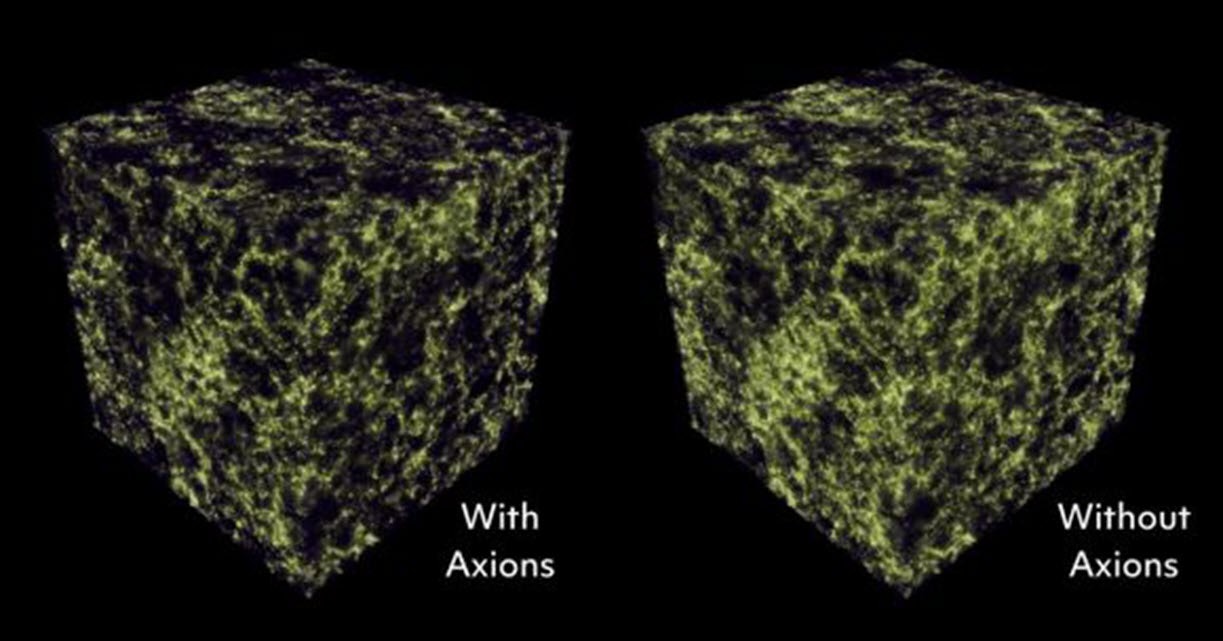
There’s some potentially big news on the hunt for dark matter. Astronomers may have a handle on what makes this mysterious cosmic stuff: strange particles called “axions.”
Rather than search directly for axions, however, a multinational team of researchers led by Keir Rogers from the University of Toronto looked for something else. They focused on the “clumpiness” of the Universe and found that cosmic matter is more evenly distributed than expected.
So, what role do axions play here? Quantum mechanics explains these ultra-light particles as “fuzzy” because they exhibit wave-like behavior. It turns out their wavelengths can be bigger than entire galaxies. Apparently, that fuzziness plays a role in smoothing out the Universe by influencing the formation and distribution of dark matter. If that’s true, then it goes a long way toward explaining why the matter in the cosmos is more evenly spread out. It implies that axions play a part in the distribution of matter in the cosmos.

It’s an interesting idea and a big step forward if the team can test their theory through other means. “If confirmed with future telescope observations and lab experiments, finding axion dark matter would be one of the most significant discoveries of this century,” said Rogers. “At the same time, our results suggest an explanation for why the Universe is less clumpy than we thought, an observation that has become increasingly clear over the last decade or so and currently leaves our theory of the Universe uncertain.”
Mapping Dark Matter
How do you figure out the effect of dark matter on “regular matter” throughout time? One way is to go back to the beginning of the cosmos and see how it was spread out at that time. To do that, Rogers’s analyzed what’s known as the Cosmic Microwave Background (CMB). It’s a relic of the light left over from the Big Bang. They used data from several big surveys of the CMB, including those from the Planck mission, the Atacama Cosmology Telescope, and the South Pole Telescope. The data gave a general “look” at the distribution of matter early on in the Universe.
The next step was to look at galaxy distribution. The team used clustering data sets from the Baryon Oscillation Spectroscopic Survey (BOSS), which contains the positions of nearly a million nearby galaxies. Essentially, they compared how things looked “way back when” with how they look in “modern” epochs of cosmic history. This showed how much the distribution of matter changed over time.
Interestingly, the distribution of galaxies also mirrors the behavior of dark matter under gravitational forces. This allowed the team to map fluctuations in the amount of matter throughout time and space. Most predictions suggested that there’d be more clumpiness in the Universe, but this analysis showed that there’s less.
Axion Implications
The next challenge was to figure out what type of dark matter could account for the unexpectedly smoother distribution of matter. The research team created computer simulations of a universe with long dark matter waves. They asked the simulations to predict the appearance of the relic light from the Big Bang and the distribution of galaxies.
The result was surprising: they looked like the actual CMB data and the “nearby” distribution of galaxies. Essentially, when dark matter is made of axions, simulations show that large-scale structures come very close to matching actual observations.
While it’s not iron-clad proof that axions are dark matter, the implications for axions are strong. Proving that they are the “stuff” of dark matter will take more observations. “We have the tools now that could enable us to finally understand something experimentally about the century-old mystery of dark matter, even in the next decade or so—and that could give us hints to answers about even bigger theoretical questions,” said Rogers. “The hope is that the puzzling elements of the Universe are solvable.”
Specifically, astronomers need to conduct more large-scale surveys of galaxies—millions of them. That could be one of the first big contributions from the soon-to-be-opened Vera Rubin Observatory in Chile. The research team could compare their theory about cosmic clumpiness to direct observations of dark matter through gravitational lensing. Dark matter gravitationally “bends” light from distant galaxies. That property allows astronomers to map the distribution of this mysterious stuff throughout the Universe.
What Else Could Dark Matter Be?
Understanding what dark matter is remains a pressing fundamental scientific question. It’s also key to understanding the origin and future of the Universe. Astronomers have suspected its existence since early in the 20th century. However, it wasn’t “proven” to exist until Vera Rubin and others made observations that provided strong evidence for “something” out there influencing the motions and distributions of galaxies.
People have come up with theoretical particles (or other objects) to explain it. Aside from axions, one idea suggests something called “weakly interacting massive particles” (WIMPS). Some have suggested neutrinos could be part of the dark matter “problem,” in addition to such objects as primordial black holes or things called massive compact halo objects (MACHOs). The latest discovery could push the theoretical definition of dark matter more firmly toward axions.
This article was originally published on Universe Today by Carolyn Collins Petersen. Read the original article here.







